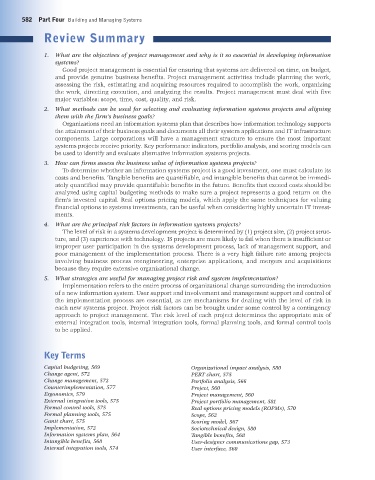Page 583 -
P. 583
582 Part Four Building and Managing Systems
Review Summary
1. What are the objectives of project management and why is it so essential in developing information
systems?
Good project management is essential for ensuring that systems are delivered on time, on budget,
and provide genuine business benefits. Project management activities include planning the work,
assessing the risk, estimating and acquiring resources required to accomplish the work, organizing
the work, directing execution, and analyzing the results. Project management must deal with five
major variables: scope, time, cost, quality, and risk.
2. What methods can be used for selecting and evaluating information systems projects and aligning
them with the firm’s business goals?
Organizations need an information systems plan that describes how information technology supports
the attainment of their business goals and documents all their system applications and IT infrastructure
components. Large corporations will have a management structure to ensure the most important
systems projects receive priority. Key performance indicators, portfolio analysis, and scoring models can
be used to identify and evaluate alternative information systems projects.
3. How can firms assess the business value of information systems projects?
To determine whether an information systems project is a good investment, one must calculate its
costs and benefits. Tangible benefits are quantifiable, and intangible benefits that cannot be immedi-
ately quantified may provide quantifiable benefits in the future. Benefits that exceed costs should be
analyzed using capital budgeting methods to make sure a project represents a good return on the
firm’s invested capital. Real options pricing models, which apply the same techniques for valuing
financial options to systems investments, can be useful when considering highly uncertain IT invest-
ments.
4. What are the principal risk factors in information systems projects?
The level of risk in a systems development project is determined by (1) project size, (2) project struc-
ture, and (3) experience with technology. IS projects are more likely to fail when there is insufficient or
improper user participation in the systems development process, lack of management support, and
poor management of the implementation process. There is a very high failure rate among projects
involving business process reengineering, enterprise applications, and mergers and acquisitions
because they require extensive organizational change.
5. What strategies are useful for managing project risk and system implementation?
Implementation refers to the entire process of organizational change surrounding the introduction
of a new information system. User support and involvement and management support and control of
the implementation process are essential, as are mechanisms for dealing with the level of risk in
each new systems project. Project risk factors can be brought under some control by a contingency
approach to project management. The risk level of each project determines the appropriate mix of
external integration tools, internal integration tools, formal planning tools, and formal control tools
to be applied.
Key Terms
Capital budgeting, 569 Organizational impact analysis, 580
Change agent, 572 PERT chart, 575
Change management, 572 Portfolio analysis, 566
Counterimplementation, 577 Project, 560
Ergonomics, 579 Project management, 560
External integration tools, 575 Project portfolio management, 581
Formal control tools, 575 Real options pricing models (ROPMs), 570
Formal planning tools, 575 Scope, 562
Gantt chart, 575 Scoring model, 567
Implementation, 572 Sociotechnical design, 580
Information systems plan, 564 Tangible benefits, 568
Intangible benefits, 568 User-designer communications gap, 573
Internal integration tools, 574 User interface, 560
MIS_13_Ch_14_global.indd 582 1/17/2013 2:32:03 PM

